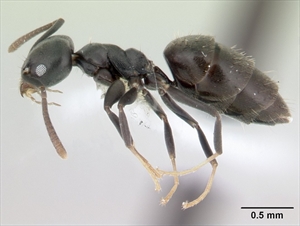- Worldwide distribution. In Australia, Cook Islands, Federated States of Micronesia, Fiji, Guam, Marshall Islands, New Caledonia, New Zealand, Niue, Palau, Papua New Guinea, Pitcairn, Samoa, Solomon Islands, Tokelau, Wallis and Futuna. Three similar white-footed species, needing specialist identification. Common in Pacific island countries.
- Major pest. Damage to plants indirect: protects natural enemies from attacking aphids, mealybugs, scales, whiteflies, encouraging outbreaks. Nests of debris on ground, in trees, in houses. Does not bite humans.
- Males, winged and wingless; three kinds females (queens, workers, 'intercastes'). Queens mate, establish colony; later, reproductive (fertilised) intercastes later take over. Foraging by (unfertilised) workers - living/dead insects, honeydew, own eggs.
- Tramp ant; spread by 'budding' - intercastes leave nest with workers, males and brood; spread with international trade.
- Biosecurity: requires risk assessments, regulations preventing introduction, protocols in case of breaches, and ability to make rapid response. Pacific Ant Prevention Plan available (IUCN/SSC Invasive Specialist Group).
- Cultural control: hot water at 47°C kills ants; over 49°C kills plants.
- Chemical control: use (i) stomach poisons (fibronil, Amdro®, borax), (ii) growth regulators (methoprene, pyriproxyfen), (iii) nerve poisons (bifenthrin, fipronil, imidacloprid). See (http://piat.org.nz/index.php?page=getting-rid-of-ants).









